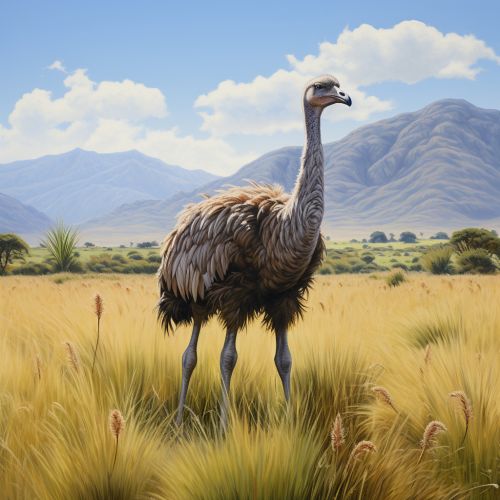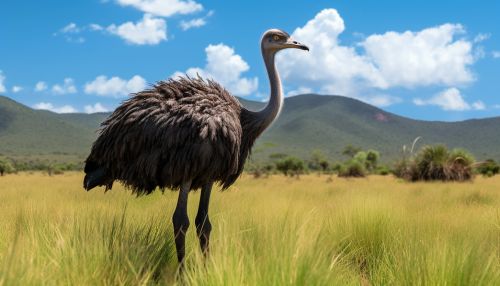Ostrich
Taxonomy and Evolution
The ostrich (Struthio camelus) is a large flightless bird native to Africa. It is the only extant species of the genus Struthio, which is in the ratite family. In the past, several species were included in the genus Struthio, but now all other species are considered extinct.
The ostrich shares the order Struthioniformes with the kiwis, emus, rheas, and cassowaries. However, genetic studies have shown that it is the basal extant member of Palaeognathae and is thus equally distant from all other living birds.


Description and Anatomy
The ostrich is the world's largest bird. Adult males can reach a height of 2.8 meters (9.2 feet) and weigh up to 156 kilograms (345 pounds). Females are somewhat smaller, but are still considerably larger than most other birds.
The ostrich's body is covered with loose, soft, black feathers, which are used in the fashion industry. The feathers on the wings and tail are white. The skin of the neck and head is nearly bare, with a thin layer of down. The eyes of the ostrich, protected by long eyelashes, are the largest of any land vertebrate, measuring 5 cm (2.0 in) in diameter.
The ostrich has a long neck and legs and the ability to run at maximum speeds of about 97.5 kilometres per hour (60.6 mph), the top land speed of any bird. Its long legs and neck keep its head up to 2.8 m (9 ft 2 in) above the ground, and its eyes are said to be the largest of any land vertebrate.
Behavior and Ecology
Ostriches are nomadic, with the size of the group changing in response to environmental conditions. They are primarily herbivorous, feeding on seeds, shrubs, grass, fruit, and flowers. However, they also consume insects and small vertebrates.
Ostriches live in nomadic groups of 5 to 50 birds that often travel together with other grazing animals, such as zebras or antelopes. They are diurnal, but may be active on moonlit nights. They are most active early and late in the day. The male ostrich is territorial and will fiercely defend his territory.
Reproduction
The ostrich is polygamous, with males mating with multiple females. The dominant male will mate with the dominant female before mating with the other females in the group. The female ostrich lays her fertilized eggs in a single communal nest, a simple pit scraped in the ground and 30 to 60 cm deep. Ostrich eggs can weigh 1.4 kg (3.1 lb) and are the largest of all eggs, though they are actually the smallest eggs relative to the size of the adult bird.
Relationship with Humans
Ostriches have been hunted and farmed for their feathers, which at various times have been popular for ornamentation in fashionable clothing (such as hats during the 19th century). Their skins are also valued for their leather. In the 21st century, ostrich farming has become widespread across the world, including in such countries as South Africa and the United States.
Conservation Status
The ostrich population is considered to be stable and is not currently threatened. They are listed as a species of least concern by the IUCN. However, like all wildlife, they are threatened by habitat loss due to human activities.
